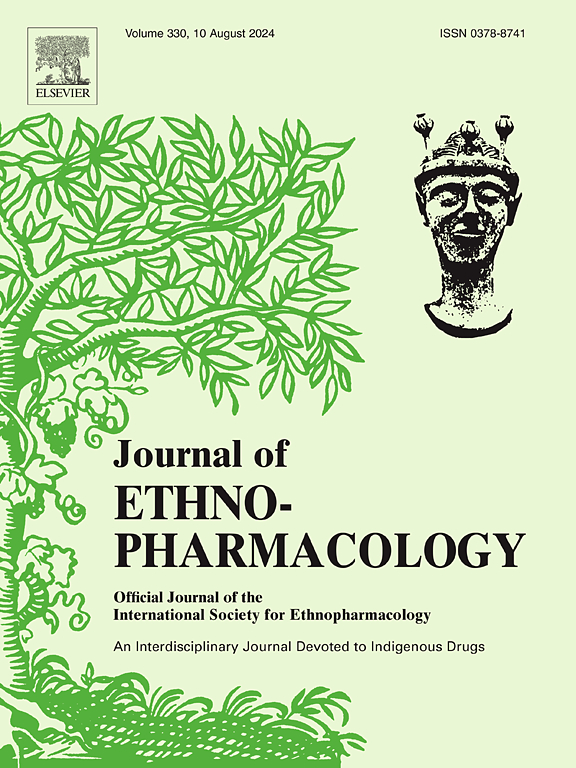Efficacy and safety of Chinese patent medicines combined with conventional therapies for endometriosis: A systematic review and bayesian network meta-analysis
IF 4.8
2区 医学
Q1 CHEMISTRY, MEDICINAL
引用次数: 0
Abstract
Ethnopharmacological relevance
Conventional hormonal treatments for endometriosis (EMs) are often associated with significant side effects. In recent years, many clinical trials and studies have highlighted the remarkable efficacy of Chinese patent medicines (CPMs) in alleviating endometriosis-related pain, reducing CA125 markers, regulating hormone levels, and preventing symptom recurrence. Numerous randomized controlled trials (RCTs) have been conducted on CPMs such as Shaofu Zhuyu Decoction (SZD), Dan'e Fukang Plaster (DFP), Sanjie Zhentong Capsule (SZC), Guizhi Fuling Capsule (GFC), Xiaojin Capsule (XC), Gongliu Xiao Capsule (GLXC), Xuefu Zhuyu Capsule (XZC), Jingtong Yushu Granule (JYG), Zhitong Huazheng Capsule (ZHC), and Kuntai Capsule (KTC) for the treatment of endometriosis. However, these studies have yet to be evaluated through a network meta-analysis (NMA) compliant with PRISMA standards.
Aim of the study
This study aimed to compare the efficacy and safety of ten CPMs for treating EMs through a NMA on RCTs.
Materials and methods
PubMed, Cochrane, Embase, Web of Science, China National Knowledge Infrastructure, VIP Information, WanFang, and China Biomedicine databases were searched up to October 2024 for studies on the efficacy and safety of CPMs in treating EMs. Two researchers independently screened the studies, extracted data, and assessed quality using the Cochrane Risk of Bias 2.0 tool and the Confidence in Network Meta-Analysis framework. The NMA was conducted using Bayesian methods with StataSE and Rstudio, generating network diagrams, league tables, and Surface Under the Cumulative Ranking (SUCRA) line charts. This study was registered with PROSPERO (CRD42023477523).
Results
148 eligible trials involving 10 CPMs and 16198 participants were included in this NMA; all subsequent estimates refer to the comparison with conventional therapies. All 10 CPMs effectively improved the total effective rate and VAS pain scores. SZC induced the most significant improvement in total effective rate(compared to hormone therapy: risk ratio 5.51, 95% confidence interval 4.21 to 7.2, SUCRA 86.3%, moderate confidence of evidence; compared to GnRH-a: 4.74, (3.18–7), moderate confidence of evidence). DFP proved to be the most effective CPM for lowering the VAS pain scores. (compared to hormone therapy: mean difference −2.1, (−2.94 to −1.29), 78.8%, moderate confidence of evidence; and GnRH-a (−2.07, (−2.73 to −1.41), low confidence of evidence). Moreover, this study demonstrated the safety of CPMs, particularly in reducing hormonal and liver-related side effects. Specific CPMs like XZC, SZC, DFP, KTC, and GFC showed markedly lower relative risks of adverse events when compared to conventional therapies.
Conclusion
Chinese patent medicine may effectively treat EMs, excelling in total effective rate, pain relief, CA125 reduction, and safety. Nevertheless, these findings are preliminary and require validation through high-quality studies.

求助全文
约1分钟内获得全文
求助全文
来源期刊

Journal of ethnopharmacology
医学-全科医学与补充医学
CiteScore
10.30
自引率
5.60%
发文量
967
审稿时长
77 days
期刊介绍:
The Journal of Ethnopharmacology is dedicated to the exchange of information and understandings about people''s use of plants, fungi, animals, microorganisms and minerals and their biological and pharmacological effects based on the principles established through international conventions. Early people confronted with illness and disease, discovered a wealth of useful therapeutic agents in the plant and animal kingdoms. The empirical knowledge of these medicinal substances and their toxic potential was passed on by oral tradition and sometimes recorded in herbals and other texts on materia medica. Many valuable drugs of today (e.g., atropine, ephedrine, tubocurarine, digoxin, reserpine) came into use through the study of indigenous remedies. Chemists continue to use plant-derived drugs (e.g., morphine, taxol, physostigmine, quinidine, emetine) as prototypes in their attempts to develop more effective and less toxic medicinals.
 求助内容:
求助内容: 应助结果提醒方式:
应助结果提醒方式:


